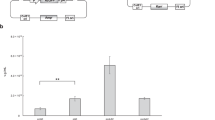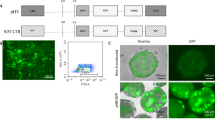Abstract
The presence of closed circular forms of the linear DNA genome of human foamy virus (HFV) has not been established. The ability of the HFV integrase (IN) to catalyse the integration of these circular forms (termed 2 long terminal repeat (LTR) circles) was investigated, with a view to producing a novel hybrid vector. To this end, a construct was made containing, in addition to the enhanced green fluorescent protein (eGFP) marker gene, the last 27 bp of the 3’ U5 LTR region of HFV fused to the first 28 bp of the 5’ U3 LTR, the latter representing a 2LTR circle. Marker gene expression following transfection of both 293 and 293T cells indicated that the level of integration was not significantly increased by the HFV IN. Moreover, correctly integrated provirus-like forms of the input plasmid could not be detected by PCR. Taken together, these results show that the HFV IN is not able to integrate a circular molecule containing an LTR junction and, hence, the technique is not exploitable as a tool to produce hybrid vectors for gene therapy.
This is a preview of subscription content, access via your institution
Access options
Subscribe to this journal
Receive 12 print issues and online access
$259.00 per year
only $21.58 per issue
Buy this article
- Purchase on Springer Link
- Instant access to full article PDF
Prices may be subject to local taxes which are calculated during checkout







Similar content being viewed by others
References
Coffin JM, Hughes SH, Varmus HE (eds). Retroviruses Cold Spring Harbor Laboratory Press 1997
Varmus H . Retroviruses Science 1988 240: 1427–1435
Fujiwara T, Mizuuchi K . Retroviral DNA integration: structure of an integration intermediate Cell 1988 54: 497–504
Brown PO, Bowerman B, Varmus HE, Bishop JM . Retroviral integration: structure of the initial covalent product and its precursor, and a role for the viral IN protein Proc Natl Acad Sci USA 1989 86: 2525–2529
Brown PO . Integration of retroviral DNA Curr Top Microbiol Immunol 1990 157: 19–48
Shoemaker C et al. Structure of a cloned circular Moloney murine leukemia virus DNA molecule containing an inverted segment: implications for retrovirus integration Proc Natl Acad Sci USA 1980 77: 3932–3936
Luciw PA, Oppermann H, Bishop JM, Varmus HE . Integration and expression of several molecular forms of Rous sarcoma virus DNA used for transfection of mouse cells Mol Cell Biol 1984 4: 1260–1269
Panganiban AT, Temin HM . Circles with two tandem LTRs are precursors to integrated retrovirus DNA Cell 1984 36: 673–679
Duyk G et al. Circles with two tandem long terminal repeats are specifically cleaved by pol gene-associated endonuclease from avian sarcoma and leukosis viruses: nucleotide sequences required for site-specific cleavage J Virol 1985 56: 589–599
Lobel LI, Murphy JE, Goff SP . The palindromic LTR-LTR junction of Moloney murine leukemia virus is not an efficient substrate for proviral integration J Virol 1989 63: 2629–2637
Lobel LI, Murphy JE, Goff SP . The palindromic LTR-LTR junction of Moloney murine leukemia virus is not an efficient substrate for proviral integration Hooks JJ, Detrick-Hooks B. Spumavirinae: foamy virus group infections: comparative aspects and diagnosis. In: Kurstak E, Kurstak C (eds). Comparative Diagnosis of Viral Diseases, vol IV. Academic Press: London, 1981, pp 599–618.
Mergia A, Leung NJ, Blackwell J . Cell tropism of the simian foamy virus type 1 (SFV-1) J Med Primatol 1996 25: 2–7
Schweizer M et al. Markers of foamy virus infections in monkeys, apes, and accidentally infected humans: appropriate testing fails to confirm suspected foamy virus prevalence in humans AIDS Res Hum Retrovir 1995 11: 161–170
Schweizer M et al. Simian foamy virus isolated from an accidentally infected human individual J Virol 1997 71: 4821–4824
Heneine W et al. Identification of a human population infected with simian foamy viruses Nat Med 1998 4: 403–407
Vassilopoulos G, Trobridge G, Josephson NC, Russell DW . Gene transfer into murine hematopoietic stem cells with helper-free foamy virus vectors Blood 2001 98: 604–609
Herchenroder O et al. Infectious proviral clones of chimpanzee foamy virus (SFVcpz) generated by long PCR reveal close functional relatedness to human foamy virus Virology 1995 214: 685–689
Herchenroder O et al. Isolation, cloning, and sequencing of simian foamy viruses from chimpanzees (SFVcpz): high homology to human foamy virus (HFV) Virology 1994 201: 187–199
Sauer B . Manipulation of transgenes by site-specific recombination: use of Cre recombinase Meth Enzymol 1993 225: 890–900
Lieber A, He CY, Kirillova I, Kay MA . Recombinant adenoviruses with large deletions generated by Cre-mediated excision exhibit different biological properties compared with first-generation vectors in vitro and in vivo J Virol 1996 70: 8944–8960
Hardy S et al. Construction of adenovirus vectors through Cre-lox recombination J Virol 1997 71: 1842–1849
Tan BT, Wu L, Berk AJ . An adenovirus-Epstein–Barr virus hybrid vector that stably transforms cultured cells with high efficiency J Virol 1999 73: 7582–7589
Vanin EF et al. Development of high-titer retroviral producer cell lines by using Cre-mediated recombination J Virol 1997 71: 7820–7826
Feng M et al. Stable in vivo gene transduction via a novel adenoviral/retroviral chimeric vector Nat Biotechnol 1997 15: 866–870
Caplen NJ . Gene therapy: different strategies for different applications. American Society of Gene Therapy: First Annual Meeting, Seattle, Washington, USA, 28–31 May 1998 Mol Med Today 1998 4: 374–375
Reynolds PN, Feng M, Curiel DT . Chimeric viral vectors – the best of both worlds? Mol Med Today 1999 5: 25–31
Duisit G, Salvetti A, Moullier P, Cosset FL . Functional characterization of adenoviral/retroviral chimeric vectors and their use for efficient screening of retroviral producer cell lines Hum Gene Ther 1999 10: 189–200
Yoshida Y, Emi N, Hamada H . VSV-G-pseudotyped retroviral packaging through adenovirus-mediated inducible gene expression Biochem Biophys Res Commun 1997 232: 379–382
Bilbao G et al. Adenoviral/retroviral vector chimeras: a novel strategy to achieve high-efficiency stable transduction in vivo FASEB J 1997 11: 624–634
Ramsey WJ et al. Adenovirus vectors as transcomplementing templates for the production of replication defective retroviral vectors Biochem Biophys Res Commun 1998 246: 912–919
Murphy SJ et al. Novel integrating adenoviral/retroviral hybrid vector for gene therapy Hum Gene Ther 2002 13: 745–760
Zheng C, Baum BJ, Iadarola MJ . O'Connell B.C. Genomic integration and gene expression by a modified adenoviral vector Nat Biotechnol 2000 18: 176–180
Link CJ . Adenoviral vectors go retro Nat Biotechnol 2000 18: 150–151
Darquet AM et al. A new DNA vehicle for nonviral gene delivery: supercoiled minicircle Gene Therapy 1997 4: 1341–1349
Enssle J et al. An active foamy virus integrase is required for virus replication J Gen Virol 1999 80: 1445–1452
Scott SD, Marples B . Comment on the use of the cre/loxP recombinase system for gene therapy vectors Gene Therapy 2000 7: 1706
Sauer B, Henderson N . Site-specific DNA recombination in mammalian cells by the Cre recombinase of bacteriophage P1 Proc Natl Acad Sci USA 1988 85: 5166–5170
Sternberg N, Hamilton D . Bacteriophage P1 site-specific recombination. I. Recombination between loxP sites J Mol Biol 1981 150: 467–486
Imrich H, Heinkelein M, Herchenroder O, Rethwilm A . Primate foamy virus pol proteins are imported into the nucleus J Gen Virol 2000 81: 2941–2947
Russell RA et al. The R region found in the human foamy virus long terminal repeat is critical for both gag and pol protein expression J Virol 2001 75: 6817–6824
Gu H, Zou YR, Rajewsky K . Independent control of immunoglobulin switch recombination at individual switch regions evidenced through Cre-loxP-mediated gene targeting Cell 1993 73: 1155–1164
Gu H, Zou YR, Rajewsky K . Independent control of immunoglobulin switch recombination at individual switch regions evidenced through Cre-loxP-mediated gene targeting Neil S, Martin P, Ikeda I, Collins M. Maturation-dependent transduction of macrophages by HIV-based vectors. 9th Meeting of the European Society of Gene Therapy, 2–4 November, Turkey, 2001.
Laemmli UK . Cleavage of structural proteins during the assembly of the head of bacteriophage T4 Nature 1970 277: 680–685
Towbin H, Staehelin T, Gordon J . Electrophoretic transfer of proteins from polyacrylamide gels to nitrocellulose sheets: procedure and some applications Proc Natl Acad Sci USA 1970 76: 4350–4354
Tosswill JHC, Taylor GP, Clewley JP, Weber JN . Quantification of proviral DNA load in human T-cell leukaemia virus type I infections J Virol Meth 1998 75: 21–26
Acknowledgements
This work was supported by The Wellcome Trust, The Jefferiss Research Trust and The Imperial Cancer Research Fund. We would like to thank Dr Richard Vile and Dr Stephen Murphy at the MAYO Institute, Rochester, MN, USA for helpful discussion.
Author information
Authors and Affiliations
Rights and permissions
About this article
Cite this article
Russell, R., Critchley, R., Vassaux, G. et al. Human foamy virus integrase fails to catalyse the integration of a circular DNA molecule containing an LTR junction sequence. Gene Ther 9, 1326–1332 (2002). https://doi.org/10.1038/sj.gt.3301795
Received:
Accepted:
Published:
Issue Date:
DOI: https://doi.org/10.1038/sj.gt.3301795



